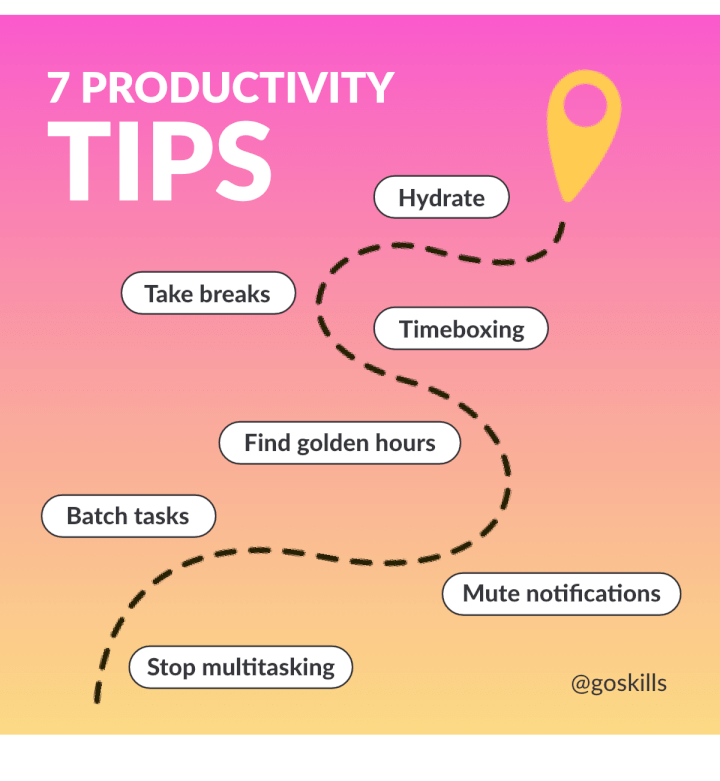Wondering how to be more productive at work?
We all want to get more done at work—to be able to head into our weekends without tons of unfinished tasks and daunting projects hanging over our heads.
But, here’s the thing: Being productive isn’t always easy. Alright, in all honesty, it hardly ever is.
Even on those days when you feel like you’re cranking through your various assignments relatively painlessly, you look down at the end of the workday and realize that somehow your to-do list is even longer than when you started.
It’s frustrating, isn’t it? You’re stuck on this hamster wheel, and that disheartening reminder makes it that much tougher to get motivated the next day.

How to be more productive at work: 7 strategies you should try
Unfortunately, there’s no magic bullet here. There’s no one single tip or hack that will allow you to snap your fingers and make your to-do list disappear—as much as we wish there was.
However, with that said, there are a few strategies you can put into play to improve your level of focus and create an environment that’s more conducive to buckling down and getting things accomplished.
If you’re someone who’s wondering how to be more productive at work (uhh...aren’t we all?), check out these seven different tips to show your to-do list who’s boss.
Want more productivity tips?
Take your productivity to the next level with our comprehensive (and free) ebook!
1. Take breaks (yes, seriously)
This one seems counterintuitive. If your aim is to get more done, shouldn’t you stay glued to your computer until your to-dos are conquered?
Not necessarily. In fact, plenty of scientific research has proven that breaks actually make you far more focused, creative and productive.
For example, one 2011 study out of the University of Illinois at Urbana-Champaign found that even brief breaks from a single task can pretty dramatically improve your ability to focus on that task for prolonged periods.
This is part of the reason why various time management methods—such as the Pomodoro Technique, where you work in 25-minute sprints with five-minute breaks in between—have become so popular in work settings.
Not only do these sorts of techniques instill a sense of urgency to get as much accomplished in a certain time block as possible, but they also have regular breaks baked in when you can refocus and recharge.
PUT THIS TIP TO WORK: Especially if you aren’t used to taking breaks, getting up and away from your desk periodically isn’t something that’s going to come naturally to you. Set a timer or a reminder that nudges you to step away at least once every hour.

2. Silence your notifications
You’re working on the slides for an upcoming presentation when you’re notified that a new email has landed in your inbox. You rip your attention away from your slide deck to check on that message.
You get back to work on that presentation, only to hear your phone buzz with a text message. Of course, you have to see who’s getting in touch. Alright, back to these slides...but now you have an Instagram notification.
Sound familiar? Distractions can quickly run our productivity levels off the rails, yet we voluntarily surround ourselves with them on a regular basis.
The gist of it is that our brains actively seek out novelty—put simply, changes in our environment. So when you’re notified that something new and potentially exciting is happening, you’re pretty much hardwired to investigate it.
It’s going to be much easier to tweak your environment as opposed to fundamentally shifting the way your brain is wired, and the best place to start is by silencing your notifications (yes, all of them!) when you really need to focus.
Eliminate the urge to repeatedly check in on those things, and you might be surprised by how much focused work you’re able to get accomplished.
PUT THIS TIP TO WORK: Close out that inbox tab in your browser. Sign out of your instant messaging application. Turn off your phone, shut off your notifications, or put that device in another room if you have to. Don’t worry—those alerts will be there waiting for you when you’re ready to devote some attention to them.
3. Resist the urge to multitask
“Nah, I don’t need to silence my notifications,” you’re thinking to yourself now. “Everybody else might struggle with those, but I’m a champion multitasker.”
Think again. I hate to burst your bubble, but nobody is skilled at multitasking. In fact, research has proven that the human brain is physically incapable of it.
So if you aren’t doing two things at once, what are you actually doing? You’re task switching—which essentially means you’re hopping back and forth between different tasks at a rapid rate. You aren’t doing them concurrently (despite the fact that it feels like you are).
This frantic (and frequent) switching of gears takes major tolls on your productivity, as it uses up more of your brain’s glucose—which is your brain’s main source of energy. Recent studies have shown that trying to multitask can decrease your productivity levels by a frightening 40%.
PUT THIS TIP TO WORK: Silencing your notifications, closing excess browser tabs, and removing that temptation is an excellent place to start. Additionally, challenge yourself to focus on only one thing at a time. The second you feel yourself wanting to change directions, use a well-known tip from James Clear and say aloud what you’re about to do. That’s usually enough to stop you in your tracks.

4. Batch your tasks
This is another strategy that can help you resist the siren song of multitasking. When you batch your tasks, you group similar to-dos together.
For example, you’ll spend an hour dedicated to reading and replying to emails, then you’ll spend a different hour brainstorming and getting prepared for some upcoming meetings, and so on and so forth.
Rather than mixing all of your different types of tasks together into one jumbled mess, you categorize them and accomplish similar tasks all at one time.
What’s the goal with this approach? Well, remember when we said that switching gears requires a lot of your brain’s glucose? Batching your tasks allows you to say in the same mindset for similar tasks—rather than doing something administrative and then jumping into something that demands a lot of creative energy before moving back into something mindless.
PUT THIS TIP TO WORK: Grab your to-do list (I know it’s right next to you) and a few different colored highlighters. Take those markers to your list and highlight items that belong together in the same color. Then, tackle them accordingly (i.e. cross off all of the yellow items before you move onto the pink ones). You just batched your tasks!
5. Find your productivity golden hours
Do you feel equally productive throughout the entire day? Of course, you don’t—you’re human. You might feel highly-focused in the morning before trudging through an after-lunch slump. Or, maybe you’re a night owl who gets your best work done after dinner.
You could write those off as personal quirks that are nice to know, or you could use them to your advantage. Science shows that we all have a different cognitive peak, and it varies based on things like our own circadian rhythms.
Figuring out exactly when you feel your most focused and motivated empowers you to schedule your more demanding tasks for those times, and leave the more mindless work (like cleaning out your inbox) for times when you feel a little less energized.
PUT THIS TIP TO WORK: It’s time to find your own productivity golden hours! You can use a time tracker to log your activities or even a simple notepad and paper to document how you feel at certain times of the day. Do that for about a week, and you’re sure to identify a trend and pick out those times when you’re at peak levels.

6. Block off time for focused work
Even if you find those hours when you’re at your very best, that doesn’t mean that life doesn’t have a knack for getting in the way. Colleagues stop by your desk unannounced and people randomly drop meetings on your calendar.
That’s why finding your golden hours is only the first part of the process—you also need to set yourself up to take full advantage of them.
One of the best ways to do this is to block off your calendar. Choose some times each day when you really want to buckle down and zone in on your work, and then physically book that time so that it’s not available to anyone else.
Moving forward, you’ll be able to treat that as your non-negotiable time when you know you’ll be able to get a lot accomplished—regardless of what distractions manage to crop up.
PUT THIS TIP TO WORK: Do you know your golden hours now? Choose one day each week when you can block off that time on your calendar and then actually do it so that you can reserve that precious time for the work you really need to accomplish.
7. Drink some (or a lot of) water
Take a minute to check in with yourself: Are you feeling sluggish? Groggy? Mentally fuzzy? Irritable?
Obviously, those emotions can quickly take your attention away from the pressing items on your to-do list. Here’s what’s even more surprising: They’re symptoms of dehydration.
While your first instinct might be to reach for another mug of coffee the second you let out a yawn, you might only be feeding a vicious cycle.
Studies estimate that up to 75% of Americans suffer from chronic dehydration. And, constantly dealing with mental fog and fatigue are only going to tank your productivity levels.
PUT THIS TIP TO WORK: Stay away from the coffee pot and get up and grab yourself a refreshing glass of water. Next? Chug it. Then fill it again and continue to sip on it as you work. You’ll be feeling a little more energized in no time.

Get ready to crush your to-do list
Remember, productivity is highly personal. What works like a charm for your co-worker might not work quite as well for you.
But even so, I think that taking steps like eliminating distractions, spending your time strategically, and fueling your body with more water certainly can’t hurt—and science agrees.
So if you’re currently struggling with that age-old “too much to do and too little time” debacle, give a few (or even all!) of the above strategies a try. You might just be surprised by how much of that lengthy to-do list you’re actually able to accomplish.
Want to learn even more about how you can become a lean, mean productivity machine? Check out our office productivity courses to find out how you can make the most of every single minute.
Bonus: Check out our favorite productivity podcasts
Want to be more productive?
Start learning for free with GoSkills courses
Start free trial



